Archaeologists working at a site near Lake Turkana in Kenya recently unearthed what may be the oldest evidence of intergroup conflict between humans. The site contained the bodies of at least 27 individuals who died at the same time, around 10,000 years ago. About 10 of those people sustained wounds consistent with violence. [Read the full story on the grisly finds in Kenya]
Ongoing excavation

The whole region around Lake Turkana is a goldmine for ancient fossils. That's because the gentle flow of sediments from the lake bury bones without destroying them, while the fluctuation of the lake levels in recent history means that bones that were once subsumed in water are gradually revealed. The new fossil finds were uncovered when researchers working with the In Africa project, which aims to find the origins of Homo sapiens, saw a few bones sticking out of the ground in Naturak, Kenya. The team came to excavate. Here, Dr Frances Rivera, Michael Emsugut and Tot Ekulukum excavate the skeleton of a woman who was felled by multiple projectiles, such as arrows. She also had several fractures in her hand. (Photo credit: Marta Mirazon Lahr)
Grisly event

Here, a skull from a man who was killed in the skirmish. The skull has several blunt force wounds suggesting he was clubbed to death. The man was likely part of a semi-nomadic hunter-gatherer group that lived predominantly around the shores of Lake Turkana. (Photo credit: Marta Mirazon Lahr enhanced by Fabio Lahr)
Weapon immortalized
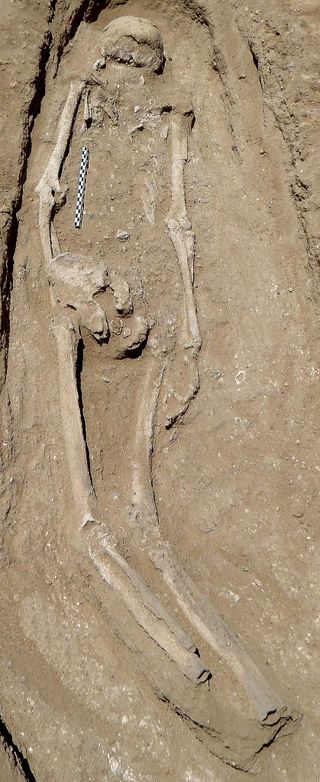
Some of the victims of violence, such as this man who was found lying prone in lagoon sediments, had a tiny obsidian blade lodged in his skull. The man also had another cut from a projectile on the other side of his skull. (Photo credit: Marta Mirazon Lahr)
Sign up for the Live Science daily newsletter now
Get the world’s most fascinating discoveries delivered straight to your inbox.
Closeup of the blade
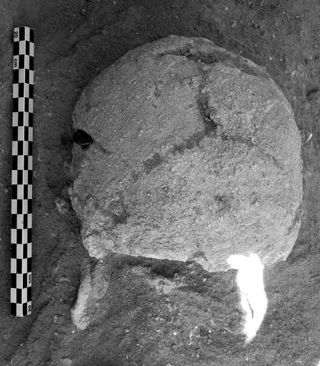
Here, a close up of the man's skull, with the blade still in place. While there are many ancient fossil skeletons that show signs of violence, it's hard to piece together whether those people died as a result of a domestic or personal squabble, or even by accident. The scale of violent death found at Naturak, combined with the fact that these people were not buried but died where they lay, strongly suggest that a violent skirmish between groups — or warfare — was to blame. (Photo credit: Marta Mirazon Lahr)
Wounded body
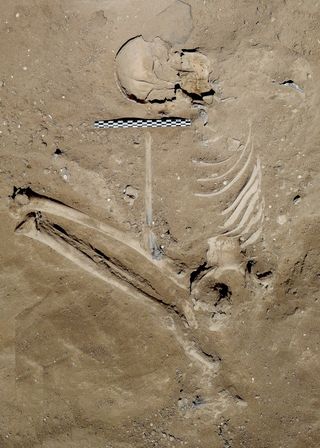
Here, another man with signs of blunt force trauma to his skull and a possible arrow wound in his neck. The total number of people killed — 27 — suggests the group of hunter-gatherers was likely larger than that. In addition, the attacking group, which used simple weapons such as clubs and arrows, was likely bigger still. (Photo credit: Marta Mirazon Lahr)
Women and children
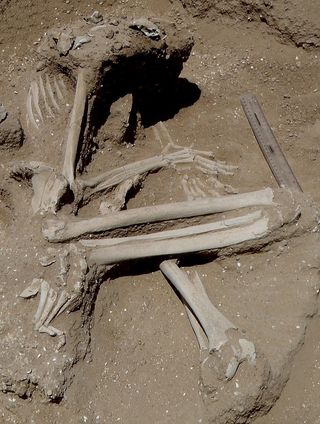
Women and children weren't spared from the violence either. Here, the skeleton of a woman who was found lying on her side. Her knees were broken and her foot also showed signs of possible fracture. Her hands were crossed in front of her, suggesting she may have been found before she died. Her skeleton was surrounded by fish fossils when it was unearthed. (Photo credit: Marta Mirazon Lahr)
Clubbing death
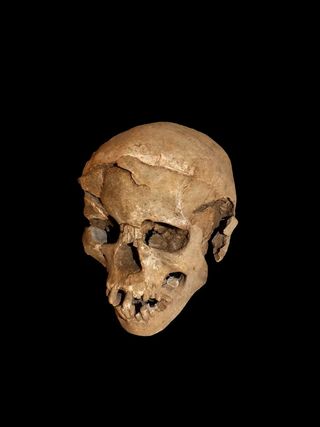
Here, the skull of a man who shows several injuries to his skull. The injuries are consistent with being clubbed with a wooden implement. The findings at Naturak could shed light on the roots of huma capacity for warfare. Some archaeologists thought that warfare only emerged with the agricultural revolution, when people stayed put and finally amassed enough stuff worth fighting over. The new discovery at Naturak suggests warfare may have older roots. (Photo credit: Marta Mirazon Lahr)
Follow Tia Ghose on Twitterand Google+. Follow Live Science @livescience, Facebook & Google+.

Tia is the managing editor and was previously a senior writer for Live Science. Her work has appeared in Scientific American, Wired.com and other outlets. She holds a master's degree in bioengineering from the University of Washington, a graduate certificate in science writing from UC Santa Cruz and a bachelor's degree in mechanical engineering from the University of Texas at Austin. Tia was part of a team at the Milwaukee Journal Sentinel that published the Empty Cradles series on preterm births, which won multiple awards, including the 2012 Casey Medal for Meritorious Journalism.
Most Popular


